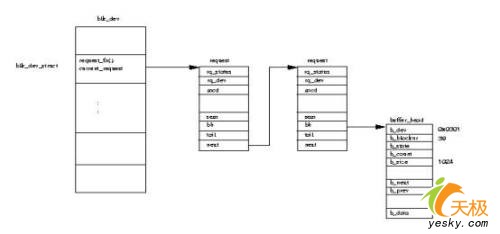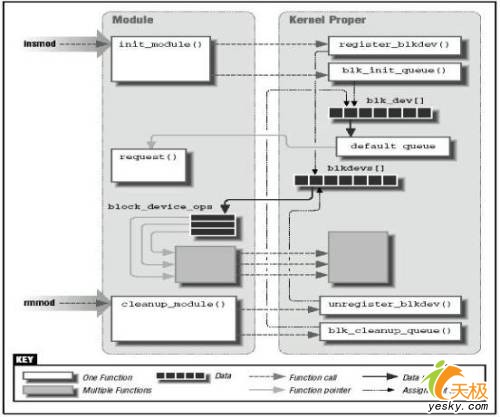基于ARM的嵌入式Linux移植真實(shí)體驗(yàn)(4)――設(shè)備驅(qū)動(dòng)
Ø 設(shè)備初始化、釋放;
Ø 提供各類設(shè)備服務(wù);
Ø 負(fù)責(zé)內(nèi)核和設(shè)備之間的數(shù)據(jù)交換;
Ø 檢測(cè)和處理設(shè)備工作過程中出現(xiàn)的錯(cuò)誤。
Linux下的設(shè)備驅(qū)動(dòng)程序被組織為一組完成不同任務(wù)的函數(shù)的集合,通過這些函數(shù)使得Linux的設(shè)備操作猶如文件一般。在應(yīng)用程序看來,硬件設(shè)備只是一個(gè)設(shè)備文件,應(yīng)用程序可以象操作普通文件一樣對(duì)硬件設(shè)備進(jìn)行操作,如open ()、close ()、read ()、write () 等。
Linux主要將設(shè)備分為二類:字符設(shè)備和塊設(shè)備。字符設(shè)備是指設(shè)備發(fā)送和接收數(shù)據(jù)以字符的形式進(jìn)行;而塊設(shè)備則以整個(gè)數(shù)據(jù)緩沖區(qū)的形式進(jìn)行。在對(duì)字符設(shè)備發(fā)出讀/寫請(qǐng)求時(shí),實(shí)際的硬件I/O一般就緊接著發(fā)生了;而塊設(shè)備則不然,它利用一塊系統(tǒng)內(nèi)存作緩沖區(qū),當(dāng)用戶進(jìn)程對(duì)設(shè)備請(qǐng)求能滿足用戶的要求,就返回請(qǐng)求的數(shù)據(jù),如果不能,就調(diào)用請(qǐng)求函數(shù)來進(jìn)行實(shí)際的I/O操作。塊設(shè)備主要針對(duì)磁盤等慢速設(shè)備。
1.內(nèi)存分配
由于Linux驅(qū)動(dòng)程序在內(nèi)核中運(yùn)行,因此在設(shè)備驅(qū)動(dòng)程序需要申請(qǐng)/釋放內(nèi)存時(shí),不能使用用戶級(jí)的malloc/free函數(shù),而需由內(nèi)核級(jí)的函數(shù)kmalloc/kfree () 來實(shí)現(xiàn),kmalloc()函數(shù)的原型為:
void kmalloc (size_t size ,int priority);
參數(shù)size為申請(qǐng)分配內(nèi)存的字節(jié)數(shù),kmalloc最多只能開辟128k的內(nèi)存;參數(shù)priority說明若kmalloc()不能馬上分配內(nèi)存時(shí)用戶進(jìn)程要采用的動(dòng)作:GFP_KERNEL 表示等待,即等kmalloc()函數(shù)將一些內(nèi)存安排到交換區(qū)來滿足你的內(nèi)存需要,GFP_ATOMIC 表示不等待,如不能立即分配到內(nèi)存則返回0 值;函數(shù)的返回值指向已分配內(nèi)存的起始地址,出錯(cuò)時(shí),返回0。
kmalloc ()分配的內(nèi)存需用kfree()函數(shù)來釋放,kfree ()被定義為:
# define kfree (n) kfree_s( (n) ,0)
其中kfree_s () 函數(shù)原型為:
void kfree_s (void * ptr ,int size);
參數(shù)ptr為kmalloc()返回的已分配內(nèi)存的指針,size是要釋放內(nèi)存的字節(jié)數(shù),若為0 時(shí),由內(nèi)核自動(dòng)確定內(nèi)存的大小。
2.中斷
許多設(shè)備涉及到中斷操作,因此,在這樣的設(shè)備的驅(qū)動(dòng)程序中需要對(duì)硬件產(chǎn)生的中斷請(qǐng)求提供中斷服務(wù)程序。與注冊(cè)基本入口點(diǎn)一樣,驅(qū)動(dòng)程序也要請(qǐng)求內(nèi)核將特定的中斷請(qǐng)求和中斷服務(wù)程序聯(lián)系在一起。在Linux中,用request_irq()函數(shù)來實(shí)現(xiàn)請(qǐng)求:
int request_irq (unsigned int irq ,void( * handler) int ,unsigned long type ,char * name);
參數(shù)irq為要中斷請(qǐng)求號(hào),參數(shù)handler為指向中斷服務(wù)程序的指針,參數(shù)type 用來確定是正常中斷還是快速中斷(正常中斷指中斷服務(wù)子程序返回后,內(nèi)核可以執(zhí)行調(diào)度程序來確定將運(yùn)行哪一個(gè)進(jìn)程;而快速中斷是指中斷服務(wù)子程序返回后,立即執(zhí)行被中斷程序,正常中斷type 取值為0 ,快速中斷type 取值為SA_INTERRUPT),參數(shù)name是設(shè)備驅(qū)動(dòng)程序的名稱。
3.字符設(shè)備驅(qū)動(dòng)
我們必須為字符設(shè)備提供一個(gè)初始化函數(shù),該函數(shù)用來完成對(duì)所控設(shè)備的初始化工作,并調(diào)用register_chrdev() 函數(shù)注冊(cè)字符設(shè)備。假設(shè)有一字符設(shè)備“exampledev”,則其init 函數(shù)為:
void exampledev_init(void)
{
if (register_chrdev(MAJOR_NUM, " exampledev ", &exampledev_fops))
TRACE_TXT("Device exampledev driver registered error");
else
TRACE_TXT("Device exampledev driver registered successfully");
…//設(shè)備初始化
}
其中,register_chrdev函數(shù)中的參數(shù)MAJOR_NUM為主設(shè)備號(hào),“exampledev”為設(shè)備名,exampledev_fops為包含基本函數(shù)入口點(diǎn)的結(jié)構(gòu)體,類型為file_operations。當(dāng)執(zhí)行exampledev_init時(shí),它將調(diào)用內(nèi)核函數(shù)register_chrdev,把驅(qū)動(dòng)程序的基本入口點(diǎn)指針存放在內(nèi)核的字符設(shè)備地址表中,在用戶進(jìn)程對(duì)該設(shè)備執(zhí)行系統(tǒng)調(diào)用時(shí)提供入口地址。
隨著內(nèi)核功能的加強(qiáng),file_operations結(jié)構(gòu)體也變得更加龐大。但是大多數(shù)的驅(qū)動(dòng)程序只是利用了其中的一部分,對(duì)于驅(qū)動(dòng)程序中無需提供的功能,只需要把相應(yīng)位置的值設(shè)為NULL。對(duì)于字符設(shè)備來說,要提供的主要入口有:open ()、release ()、read ()、write ()、ioctl ()等。
open()函數(shù) 對(duì)設(shè)備特殊文件進(jìn)行open()系統(tǒng)調(diào)用時(shí),將調(diào)用驅(qū)動(dòng)程序的open () 函數(shù):
int (*open)(struct inode * inode,struct file *filp);
其中參數(shù)inode為設(shè)備特殊文件的inode (索引結(jié)點(diǎn)) 結(jié)構(gòu)的指針,參數(shù)filp是指向這一設(shè)備的文件結(jié)構(gòu)的指針。open()的主要任務(wù)是確定硬件處在就緒狀態(tài)、驗(yàn)證次設(shè)備號(hào)的合法性(次設(shè)備號(hào)可以用MINOR(inode-> i_rdev) 取得)、控制使用設(shè)備的進(jìn)程數(shù)、根據(jù)執(zhí)行情況返回狀態(tài)碼(0表示成功,負(fù)數(shù)表示存在錯(cuò)誤) 等;
release()函數(shù) 當(dāng)最后一個(gè)打開設(shè)備的用戶進(jìn)程執(zhí)行close ()系統(tǒng)調(diào)用時(shí),內(nèi)核將調(diào)用驅(qū)動(dòng)程序的release () 函數(shù):
void (*release) (struct inode * inode,struct file *filp) ;
release 函數(shù)的主要任務(wù)是清理未結(jié)束的輸入/輸出操作、釋放資源、用戶自定義排他標(biāo)志的復(fù)位等。
read()函數(shù) 當(dāng)對(duì)設(shè)備特殊文件進(jìn)行read() 系統(tǒng)調(diào)用時(shí),將調(diào)用驅(qū)動(dòng)程序read() 函數(shù):
ssize_t (*read) (struct file * filp, char * buf, size_t count, loff_t * offp);
參數(shù)buf是指向用戶空間緩沖區(qū)的指針,由用戶進(jìn)程給出,count 為用戶進(jìn)程要求讀取的字節(jié)數(shù),也由用戶給出。
read() 函數(shù)的功能就是從硬設(shè)備或內(nèi)核內(nèi)存中讀取或復(fù)制count個(gè)字節(jié)到buf 指定的緩沖區(qū)中。在復(fù)制數(shù)據(jù)時(shí)要注意,驅(qū)動(dòng)程序運(yùn)行在內(nèi)核中,而buf指定的緩沖區(qū)在用戶內(nèi)存區(qū)中,是不能直接在內(nèi)核中訪問使用的,因此,必須使用特殊的復(fù)制函數(shù)來完成復(fù)制工作,這些函數(shù)在include/asm/uaccess.h中被聲明:
unsigned long copy_to_user (void * to, void * from, unsigned long len);
此外,put_user()函數(shù)用于內(nèi)核空間和用戶空間的單值交互(如char、int、long)。
write( )函數(shù) 當(dāng)設(shè)備特殊文件進(jìn)行write () 系統(tǒng)調(diào)用時(shí),將調(diào)用驅(qū)動(dòng)程序的write () 函數(shù):
ssize_t (*write) (struct file *, const char *, size_t, loff_t *);
write ()的功能是將參數(shù)buf 指定的緩沖區(qū)中的count 個(gè)字節(jié)內(nèi)容復(fù)制到硬件或內(nèi)核內(nèi)存中,和read() 一樣,復(fù)制工作也需要由特殊函數(shù)來完成:
unsigned long copy_from_user(void *to, const void *from, unsigned long n);
此外,get_user()函數(shù)用于內(nèi)核空間和用戶空間的單值交互(如char、int、long)。
ioctl()函數(shù) 該函數(shù)是特殊的控制函數(shù),可以通過它向設(shè)備傳遞控制信息或從設(shè)備取得狀態(tài)信息,函數(shù)原型為:
int (*ioctl) (struct inode * inode,struct file * filp,unsigned int cmd,unsigned long arg);
參數(shù)cmd為設(shè)備驅(qū)動(dòng)程序要執(zhí)行的命令的代碼,由用戶自定義,參數(shù)arg 為相應(yīng)的命令提供參數(shù),類型可以是整型、指針等。
同樣,在驅(qū)動(dòng)程序中,這些函數(shù)的定義也必須符合命名規(guī)則,按照本文約定,設(shè)備“exampledev”的驅(qū)動(dòng)程序的這些函數(shù)應(yīng)分別命名為exampledev_open、exampledev_ release、exampledev_read、exampledev_write、exampledev_ioctl,因此設(shè)備“exampledev”的基本入口點(diǎn)結(jié)構(gòu)變量exampledev_fops 賦值如下(對(duì)較早版本的內(nèi)核):
struct file_operations exampledev_fops {
NULL ,
exampledev_read ,
exampledev_write ,
NULL ,
NULL ,
exampledev_ioctl ,
NULL ,
exampledev_open ,
exampledev_release ,
NULL ,
NULL ,
NULL ,
NULL
} ;
就目前而言,由于file_operations結(jié)構(gòu)體已經(jīng)很龐大,我們更適合用GNU擴(kuò)展的C語法來初始化exampledev_fops:
struct file_operations exampledev_fops = {
read: exampledev _read,
write: exampledev _write,
ioctl: exampledev_ioctl ,
open: exampledev_open ,
release : exampledev_release ,
};
看看第一章電路板硬件原理圖,板上包含四個(gè)用戶可編程的發(fā)光二極管(LED),這些LED連接在ARM處理器的可編程I/O口(GPIO)上,現(xiàn)在來編寫這些LED的驅(qū)動(dòng):
#include
#include
#include
#include
#include
#include
#include
#define DEVICE_NAME "leds" /*定義led 設(shè)備的名字*/
#define LED_MAJOR 231 /*定義led 設(shè)備的主設(shè)備號(hào)*/
static unsigned long led_table[] =
{
/*I/O 方式led 設(shè)備對(duì)應(yīng)的硬件資源*/
GPIO_B10, GPIO_B8, GPIO_B5, GPIO_B6,
};
/*使用ioctl 控制led*/
static int leds_ioctl(struct inode *inode, struct file *file, unsigned int cmd,
unsigned long arg)
{
switch (cmd)
{
case 0:
case 1:
if (arg > 4)
{
return -EINVAL;
}
write_gpio_bit(led_table[arg], !cmd);
default:
return -EINVAL;
}
}
static struct file_operations leds_fops =
{
owner: THIS_MODULE, ioctl: leds_ioctl,
};
static devfs_handle_t devfs_handle;
static int __init leds_init(void)
{
int ret;
int i;
/*在內(nèi)核中注冊(cè)設(shè)備*/
ret = register_chrdev(LED_MAJOR, DEVICE_NAME, &leds_fops);
if (ret < 0)
{
printk(DEVICE_NAME " cant register major numbern");
return ret;
}
devfs_handle = devfs_register(NULL, DEVICE_NAME, DEVFS_FL_DEFAULT, LED_MAJOR,
0, S_IFCHR | S_IRUSR | S_IWUSR, &leds_fops, NULL);
/*使用宏進(jìn)行端口初始化,set_gpio_ctrl 和write_gpio_bit 均為宏定義*/
for (i = 0; i < 8; i++)
{
set_gpio_ctrl(led_table[i] | GPIO_PULLUP_EN | GPIO_MODE_OUT);
write_gpio_bit(led_table[i], 1);
}
printk(DEVICE_NAME " initializedn");
return 0;
}
static void __exit leds_exit(void)
{
devfs_unregister(devfs_handle);
unregister_chrdev(LED_MAJOR, DEVICE_NAME);
}
module_init(leds_init);
module_exit(leds_exit);
使用命令方式編譯led 驅(qū)動(dòng)模塊:
#arm-linux-gcc -D__KERNEL__ -I/arm/kernel/include
-DKBUILD_BASENAME=leds -DMODULE -c -o leds.o leds.c
以上命令將生成leds.o 文件,把該文件復(fù)制到板子的/lib目錄下,使用以下命令就可以安裝leds驅(qū)動(dòng)模塊:
#insmod /lib/ leds.o
刪除該模塊的命令是:
#rmmod leds
4.塊設(shè)備驅(qū)動(dòng)
塊設(shè)備驅(qū)動(dòng)程序的編寫是一個(gè)浩繁的工程,其難度遠(yuǎn)超過字符設(shè)備,上千行的代碼往往只能搞定一個(gè)簡單的塊設(shè)備,而數(shù)十行代碼就可能搞定一個(gè)字符設(shè)備。因此,非得有相當(dāng)?shù)幕竟Σ拍芡瓿纱隧?xiàng)工作。下面先給出一個(gè)實(shí)例,即mtdblock塊設(shè)備的驅(qū)動(dòng)。我們通過分析此實(shí)例中的代碼來說明塊設(shè)備驅(qū)動(dòng)程序的寫法(由于篇幅的關(guān)系,大量的代碼被省略,只保留了必要的主干):
#include
#include
static void mtd_notify_add(struct mtd_info* mtd);
static void mtd_notify_remove(struct mtd_info* mtd);
static struct mtd_notifier notifier = {
mtd_notify_add,
mtd_notify_remove,
NULL
};
static devfs_handle_t devfs_dir_handle = NULL;
static devfs_handle_t devfs_rw_handle[MAX_MTD_DEVICES];
static struct mtdblk_dev {
struct mtd_info *mtd; /* Locked */
int count;
struct semaphore cache_sem;
unsigned char *cache_data;
unsigned long cache_offset;
unsigned int cache_size;
enum { STATE_EMPTY, STATE_CLEAN, STATE_DIRTY } cache_state;
} *mtdblks[MAX_MTD_DEVICES];
static spinlock_t mtdblks_lock;
/* this lock is used just in kernels >= 2.5.x */
static spinlock_t mtdblock_lock;
static int mtd_sizes[MAX_MTD_DEVICES];
static int mtd_blksizes[MAX_MTD_DEVICES];
static void erase_callback(struct erase_info *done)
{
wait_queue_head_t *wait_q = (wait_queue_head_t *)done->priv;
wake_up(wait_q);
}
static int erase_write (struct mtd_info *mtd, unsigned long pos,
int len, const char *buf)
{
struct erase_info erase;
DECLARE_WAITQUEUE(wait, current);
wait_queue_head_t wait_q;
size_t retlen;
int ret;
/*
* First, lets erase the flash block.
*/
init_waitqueue_head(&wait_q);
erase.mtd = mtd;
erase.callback = erase_callback;
erase.addr = pos;
erase.len = len;
erase.priv = (u_long)&wait_q;
set_current_state(TASK_INTERRUPTIBLE);
add_wait_queue(&wait_q, &wait);
ret = MTD_ERASE(mtd, &erase);
if (ret) {
set_current_state(TASK_RUNNING);
remove_wait_queue(&wait_q, &wait);
printk (KERN_WARNING "mtdblock: erase of region [0x%lx, 0x%x] "
"on "%s" failedn",
pos, len, mtd->name);
return ret;
}
schedule(); /* Wait for erase to finish. */
remove_wait_queue(&wait_q, &wait);
/*
* Next, writhe data to flash.
*/
ret = MTD_WRITE (mtd, pos, len, &retlen, buf);
if (ret)
return ret;
if (retlen != len)
return -EIO;
return 0;
}
static int write_cached_data (struct mtdblk_dev *mtdblk)
{
struct mtd_info *mtd = mtdblk->mtd;
int ret;
if (mtdblk->cache_state != STATE_DIRTY)
return 0;
DEBUG(MTD_DEBUG_LEVEL2, "mtdblock: writing cached data for "%s" "
"at 0x%lx, size 0x%xn", mtd->name,
mtdblk->cache_offset, mtdblk->cache_size);
ret = erase_write (mtd, mtdblk->cache_offset,
mtdblk->cache_size, mtdblk->cache_data);
if (ret)
return ret;
mtdblk->cache_state = STATE_EMPTY;
return 0;
}
static int do_cached_write (struct mtdblk_dev *mtdblk, unsigned long pos,
int len, const char *buf)
{
…
}
static int do_cached_read (struct mtdblk_dev *mtdblk, unsigned long pos,
int len, char *buf)
{
…
}
static int mtdblock_open(struct inode *inode, struct file *file)
{
…
}
static release_t mtdblock_release(struct inode *inode, struct file *file)
{
int dev;
struct mtdblk_dev *mtdblk;
DEBUG(MTD_DEBUG_LEVEL1, "mtdblock_releasen");
if (inode == NULL)
release_return(-ENODEV);
dev = minor(inode->i_rdev);
mtdblk = mtdblks[dev];
down(&mtdblk->cache_sem);
write_cached_data(mtdblk);
up(&mtdblk->cache_sem);
spin_lock(&mtdblks_lock);
if (!--mtdblk->count) {
/* It was the last usage. Free the device */
mtdblks[dev] = NULL;
spin_unlock(&mtdblks_lock);
if (mtdblk->mtd->sync)
mtdblk->mtd->sync(mtdblk->mtd);
put_mtd_device(mtdblk->mtd);
vfree(mtdblk->cache_data);
kfree(mtdblk);
} else {
spin_unlock(&mtdblks_lock);
}
DEBUG(MTD_DEBUG_LEVEL1, "okn");
BLK_DEC_USE_COUNT;
release_return(0);
}
/*
* This is a special request_fn because it is executed in a process context
* to be able to sleep independently of the caller. The
* io_request_lock (for <2.5) or queue_lock (for >=2.5) is held upon entry
* and exit. The head of our request queue is considered active so there is
* no need to dequeue requests before we are done.
*/
static void handle_mtdblock_request(void)
{
struct request *req;
struct mtdblk_dev *mtdblk;
unsigned int res;
for (;;) {
INIT_REQUEST;
req = CURRENT;
spin_unlock_irq(QUEUE_LOCK(QUEUE));
mtdblk = mtdblks[minor(req->rq_dev)];
res = 0;
if (minor(req->rq_dev) >= MAX_MTD_DEVICES)
panic("%s : minor out of bound", __FUNCTION__);
if (!IS_REQ_CMD(req))
goto end_req;
if ((req->sector + req->current_nr_sectors) > (mtdblk->mtd->size >> 9))
goto end_req;
// Handle the request
switch (rq_data_dir(req))
{
int err;
case READ:
down(&mtdblk->cache_sem);
err = do_cached_read (mtdblk, req->sector << 9,
req->current_nr_sectors << 9,
req->buffer);
up(&mtdblk->cache_sem);
if (!err)
res = 1;
break;
case WRITE:
// Read only device
if ( !(mtdblk->mtd->flags & MTD_WRITEABLE) )
break;
// Do the write
down(&mtdblk->cache_sem);
err = do_cached_write (mtdblk, req->sector << 9,
req->current_nr_sectors << 9,
req->buffer);
up(&mtdblk->cache_sem);
if (!err)
res = 1;
break;
}
end_req:
spin_lock_irq(QUEUE_LOCK(QUEUE));
end_request(res);
}
}
static volatile int leaving = 0;
static DECLARE_MUTEX_LOCKED(thread_sem);
static DECLARE_WAIT_QUEUE_HEAD(thr_wq);
int mtdblock_thread(void *dummy)
{
…
}
#define RQFUNC_ARG request_queue_t *q
static void mtdblock_request(RQFUNC_ARG)
{
/* Dont do anything, except wake the thread if necessary */
wake_up(&thr_wq);
}
static int mtdblock_ioctl(struct inode * inode, struct file * file,
unsigned int cmd, unsigned long arg)
{
struct mtdblk_dev *mtdblk;
mtdblk = mtdblks[minor(inode->i_rdev)];
switch (cmd) {
case BLKGETSIZE: /* Return device size */
return put_user((mtdblk->mtd->size >> 9), (unsigned long *) arg);
case BLKFLSBUF:
if(!capable(CAP_SYS_ADMIN))
return -EACCES;
fsync_dev(inode->i_rdev);
invalidate_buffers(inode->i_rdev);
down(&mtdblk->cache_sem);
write_cached_data(mtdblk);
up(&mtdblk->cache_sem);
if (mtdblk->mtd->sync)
mtdblk->mtd->sync(mtdblk->mtd);
return 0;
default:
return -EINVAL;
}
}
static struct block_device_operations mtd_fops =
{
owner: THIS_MODULE,
open: mtdblock_open,
release: mtdblock_release,
ioctl: mtdblock_ioctl
};
static void mtd_notify_add(struct mtd_info* mtd)
{
…
}
static void mtd_notify_remove(struct mtd_info* mtd)
{
if (!mtd || mtd->type == MTD_ABSENT)
return;
devfs_unregister(devfs_rw_handle[mtd->index]);
}
int __init init_mtdblock(void)
{
int i;
spin_lock_init(&mtdblks_lock);
/* this lock is used just in kernels >= 2.5.x */
spin_lock_init(&mtdblock_lock);
#ifdef CONFIG_DEVFS_FS
if (devfs_register_blkdev(MTD_BLOCK_MAJOR, DEVICE_NAME, &mtd_fops))
{
printk(KERN_NOTICE "Cant allocate major number %d for Memory Technology Devices.n",
MTD_BLOCK_MAJOR);
return -EAGAIN;
}
devfs_dir_handle = devfs_mk_dir(NULL, DEVICE_NAME, NULL);
register_mtd_user(¬ifier);
#else
if (register_blkdev(MAJOR_NR,DEVICE_NAME,&mtd_fops)) {
printk(KERN_NOTICE "Cant allocate major number %d for Memory Technology Devices.n",
MTD_BLOCK_MAJOR);
return -EAGAIN;
}
#endif
/* We fill it in at open() time. */
for (i=0; i< MAX_MTD_DEVICES; i++) {
mtd_sizes[i] = 0;
mtd_blksizes[i] = BLOCK_SIZE;
}
init_waitqueue_head(&thr_wq);
/* Allow the block size to default to BLOCK_SIZE. */
blksize_size[MAJOR_NR] = mtd_blksizes;
blk_size[MAJOR_NR] = mtd_sizes;
BLK_INIT_QUEUE(BLK_DEFAULT_QUEUE(MAJOR_NR), &mtdblock_request, &mtdblock_lock);
kernel_thread (mtdblock_thread, NULL, CLONE_FS|CLONE_FILES|CLONE_SIGHAND);
return 0;
}
static void __exit cleanup_mtdblock(void)
{
leaving = 1;
wake_up(&thr_wq);
down(&thread_sem);
#ifdef CONFIG_DEVFS_FS
unregister_mtd_user(¬ifier);
devfs_unregister(devfs_dir_handle);
devfs_unregister_blkdev(MTD_BLOCK_MAJOR, DEVICE_NAME);
#else
unregister_blkdev(MAJOR_NR,DEVICE_NAME);
#endif
blk_cleanup_queue(BLK_DEFAULT_QUEUE(MAJOR_NR));
blksize_size[MAJOR_NR] = NULL;
blk_size[MAJOR_NR] = NULL;
}
module_init(init_mtdblock);
module_exit(cleanup_mtdblock);
從上述源代碼中我們發(fā)現(xiàn),塊設(shè)備也以與字符設(shè)備register_chrdev、unregister_ chrdev 函數(shù)類似的方法進(jìn)行設(shè)備的注冊(cè)與釋放:
int register_blkdev(unsigned int major, const char *name, struct block_device_operations *bdops);
int unregister_blkdev(unsigned int major, const char *name);
但是,register_chrdev使用一個(gè)向 file_operations 結(jié)構(gòu)的指針,而register_blkdev 則使用 block_device_operations 結(jié)構(gòu)的指針,其中定義的open、release 和 ioctl 方法和字符設(shè)備的對(duì)應(yīng)方法相同,但未定義 read 或者 write 操作。這是因?yàn)?,所有涉及到塊設(shè)備的 I/O 通常由系統(tǒng)進(jìn)行緩沖處理。
塊驅(qū)動(dòng)程序最終必須提供完成實(shí)際塊 I/O 操作的機(jī)制,在 Linux 當(dāng)中,用于這些 I/O 操作的方法稱為“request(請(qǐng)求)”。在塊設(shè)備的注冊(cè)過程中,需要初始化request隊(duì)列,這一動(dòng)作通過blk_init_queue來完成,blk_init_queue函數(shù)建立隊(duì)列,并將該驅(qū)動(dòng)程序的 request 函數(shù)關(guān)聯(lián)到隊(duì)列。在模塊的清除階段,應(yīng)調(diào)用 blk_cleanup_queue 函數(shù)。
本例中相關(guān)的代碼為:
BLK_INIT_QUEUE(BLK_DEFAULT_QUEUE(MAJOR_NR), &mtdblock_request, &mtdblock_lock);
blk_cleanup_queue(BLK_DEFAULT_QUEUE(MAJOR_NR));
每個(gè)設(shè)備有一個(gè)默認(rèn)使用的請(qǐng)求隊(duì)列,必要時(shí),可使用 BLK_DEFAULT_QUEUE(major) 宏得到該默認(rèn)隊(duì)列。這個(gè)宏在 blk_dev_struct 結(jié)構(gòu)形成的全局?jǐn)?shù)組(該數(shù)組名為 blk_dev)中搜索得到對(duì)應(yīng)的默認(rèn)隊(duì)列。blk_dev 數(shù)組由內(nèi)核維護(hù),并可通過主設(shè)備號(hào)索引。blk_dev_struct 接口定義如下:
struct blk_dev_struct {
/*
* queue_proc has to be atomic
*/
request_queue_t request_queue;
queue_proc *queue;
void *data;
};
request_queue 成員包含了初始化之后的 I/O 請(qǐng)求隊(duì)列,data 成員可由驅(qū)動(dòng)程序使用,以便保存一些私有數(shù)據(jù)。
request_queue定義為:
struct request_queue
{
/*
* the queue request freelist, one for reads and one for writes
*/
struct request_list rq[2];
/*
* Together with queue_head for cacheline sharing
*/
struct list_head queue_head;
elevator_t elevator;
request_fn_proc * request_fn;
merge_request_fn * back_merge_fn;
merge_request_fn * front_merge_fn;
merge_requests_fn * merge_requests_fn;
make_request_fn * make_request_fn;
plug_device_fn * plug_device_fn;
/*
* The queue owner gets to use this for whatever they like.
* ll_rw_blk doesnt touch it.
*/
void * queuedata;
/*
* This is used to remove the plug when tq_disk runs.
*/
struct tq_struct plug_tq;
/*
* Boolean that indicates whether this queue is plugged or not.
*/
char plugged;
/*
* Boolean that indicates whether current_request is active or
* not.
*/
char head_active;
/*
* Is meant to protect the queue in the future instead of
* io_request_lock
*/
spinlock_t queue_lock;
/*
* Tasks wait here for free request
*/
wait_queue_head_t wait_for_request;
};
下圖表征了blk_dev、blk_dev_struct和request_queue的關(guān)系:

下圖則表征了塊設(shè)備的注冊(cè)和釋放過程:

5.小結(jié)
本章講述了Linux設(shè)備驅(qū)動(dòng)程序的入口函數(shù)及驅(qū)動(dòng)程序中的內(nèi)存申請(qǐng)、中斷等,并分別以實(shí)例講述了字符設(shè)備及塊設(shè)備的驅(qū)動(dòng)開發(fā)方法。



評(píng)論